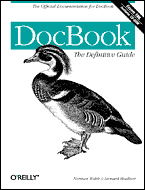DocBook: The Definitive Guide
 | By Norman Walsh & Leonard Muellner 1st Edition October 1999 1-56592-580-7, Order Number: 5807 652 pages, $36.95 , Includes CD-ROM |
| DocBook: The Definitive Guide | ||
|---|---|---|
| Prev | Next | |
Name
SGMLTag -- A component of SGML markupSynopsis
Mixed Content Model
SGMLTag ::= ((#PCDATA|Replaceable|InlineGraphic|InlineMediaObject|IndexTerm)+)
Attributes
Common attributes
Name | Type | Default |
| Class | Enumeration: Attribute | None |
Tag Minimization
Both the start- and end-tags are required for this element.
Parameter Entities
Description
An SGMLTag identifies an SGML markup construct. The utility of this element is almost wholly constrained to books about SGML.
SGMLTag is sufficient for most XML constructs, which are identical to the corresponding SGML constructs, it but does not have any provisions for handling the special features of XML markup. A future version of DocBook will address this issue, probably by adding new Class values. In the meantime, you may get by by assigning a Role attribute for XML.
Processing expectations
Formatted inline. SGMLTag generates all the necessary punctuation before and after the construct it identifies. For example, it generates both the leading ampersand and the trailing semicolon when the Class is genentity.
Parents
These elements contain SGMLTag: Action, Application, Attribution, BiblioMisc, BridgeHead, Citation, CiteTitle, Command, Comment, ComputerOutput, Database, Emphasis, entry, Filename, ForeignPhrase, FuncParams, FuncSynopsisInfo, Function, GlossSee, GlossSeeAlso, GlossTerm, Hardware, Interface, InterfaceDefinition, KeyCap, LineAnnotation, Link, Literal, LiteralLayout, LoTentry, Member, MsgAud, OLink, Option, Optional, Para, Parameter, Phrase, Primary, PrimaryIE, ProductName, ProgramListing, Property, Quote, RefDescriptor, RefEntryTitle, RefName, RefPurpose, Screen, ScreenInfo, Secondary, SecondaryIE, See, SeeAlso, SeeAlsoIE, SeeIE, Seg, SegTitle, SimPara, Subtitle, Synopsis, SystemItem, Term, Tertiary, TertiaryIE, Title, TitleAbbrev, ToCback, ToCentry, ToCfront, Trademark, ULink, UserInput.